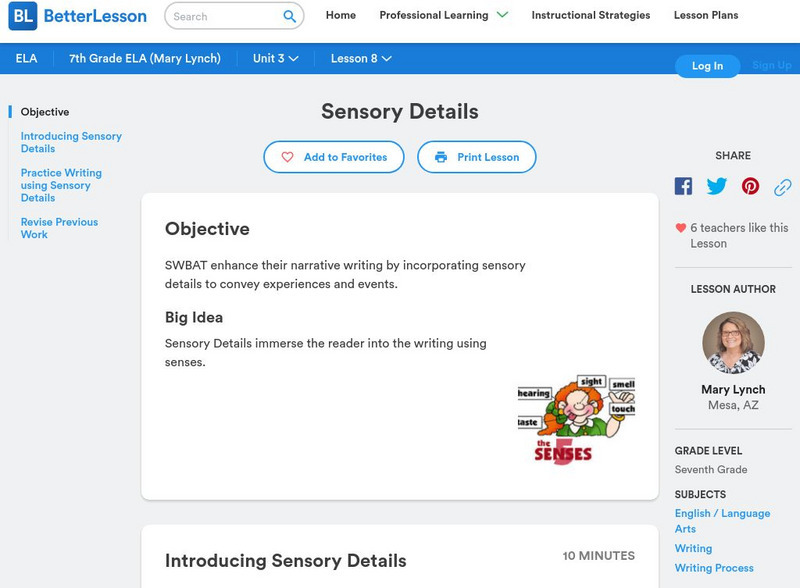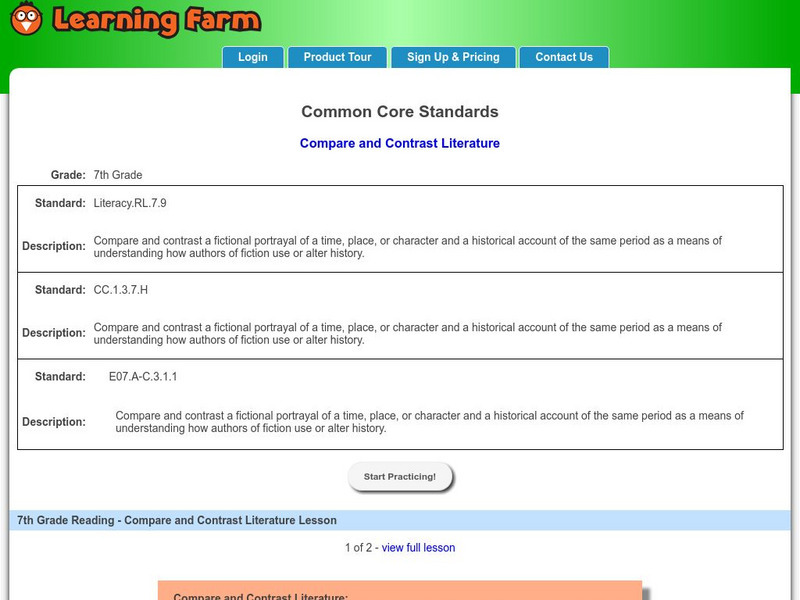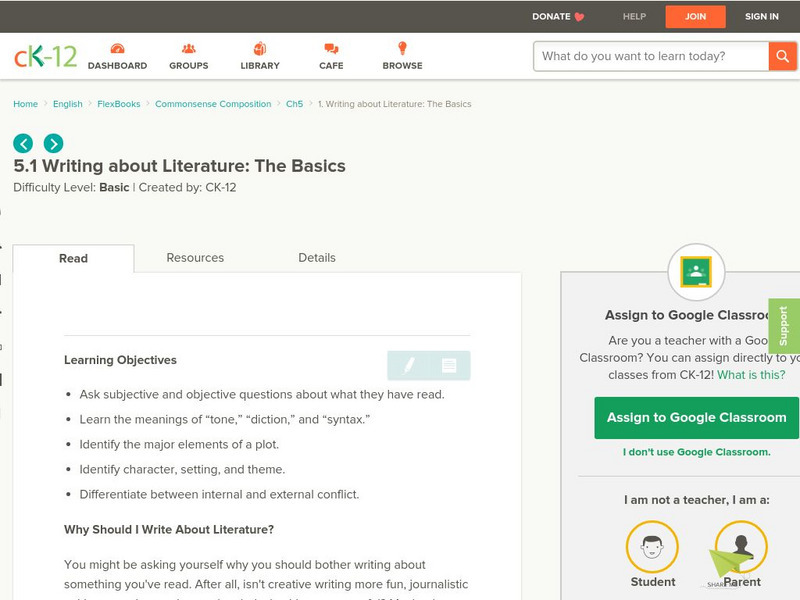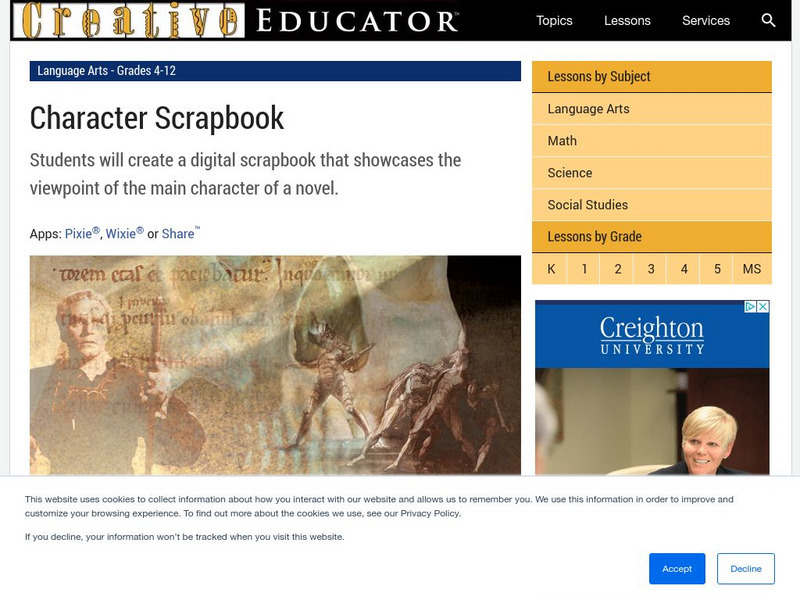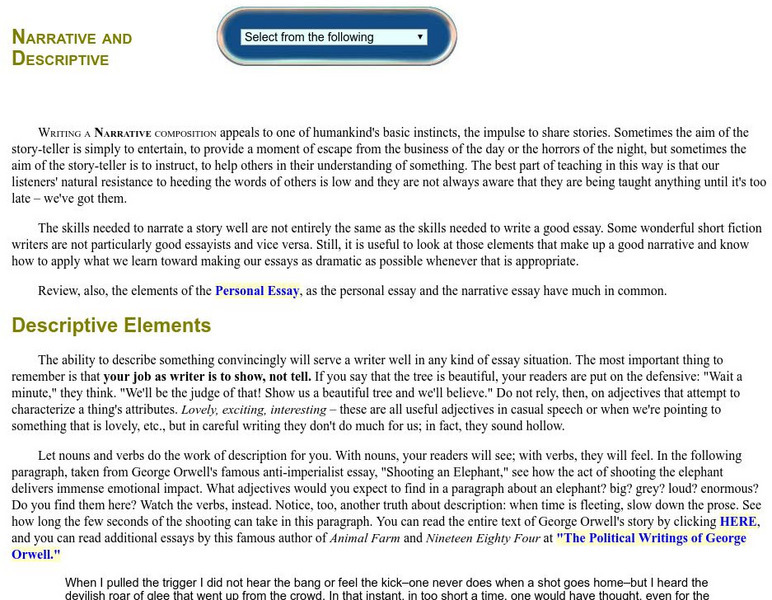Writing Fix
Writing Fix: Mechanical Monsters
In this lesson, students read the description of the mechanical dog from Ray Bradbury's Fahrenheit 451 and then work in groups to create and write descriptions of their own futuristic pet.
Quizlet
Quizlet: Ccisd 4th Grade Main Idea Match
Reading comprehension terms (nonfiction) are included in this review "Match" game. Questions are provided for the following words: main idea, summarizing, point of view, summarizing, topic, support, conclusion, details, author's purpose,...
Quizlet
Quizlet: R.3 Analyze How and Why Individuals, Events, or Ideas, Develop/interact
Please align to CCSS.ELA-Literacy.CCRA.R.3 Analyze how and why individuals, events, and ideas develop and interact over the course of a text.
Other
Ksu: Point of View: First Person Narrator
This tutorial surveys the uses and limitations of first-person narration in literature. CCSS.ELA-Literacy.CCRA.R.9
Other
Thoughtful Learning: ccss.ela literacy.w.7.3.a
Pick and choose from these lessons and units that focus on narrative writing. Specifically, how to establish a context and point of view, introduce characters, and organize an event sequence.
Better Lesson
Better Lesson: Sensory Details
Students will learn how to enhance their narrative writing by incorporating sensory details to convey experiences and events. A power point presentation on sensory details is included.
Learning Farm
Learning Farm: Compare and Contrast Literature
Students will learn how to compare and contrast passages from different time periods. Analyzing the similarities and differences of in the way authors show a historical time, place, or a character gives the reader a broader understanding...
Texas Education Agency
Texas Gateway: Analyze Point of View in Literary Texts/fiction
[Accessible by TX Educators. Free Registration/Login Required] In this lesson, you will learn to identify the primary points of view used in fiction and weigh the advantages and disadvantages of each.
Texas Education Agency
Texas Gateway: Analyze the Central Characters in Literary Text/fiction
In this lesson, you will discover some ways that writers reveal the complexity of their characters. By closely analyzing one author's characters, you'll come to see how their words, actions, and interactions with one another can shape a...
Annenberg Foundation
Annenberg Learner: Literature: Exploring Point of View
This page explains point of view by discussing examples of situations where mutiple people witness an event, but have different perspectives on what occured. It offers a link at the bottom of the page to information about types of point...
E Reading Worksheets
E Reading Worksheets: Writing Narrative Essays
This article provides the components of narrative writing. The author emphasizes ways to make narrative writing better. W.9-10.3e Conclusion
CK-12 Foundation
Ck 12: 6.1 Writing About Literature: Analyzing Prose
[Free Registration/Login may be required to access all resource tools.] Learn to analyze prose by understanding connotation and denotation, identifying metaphors and similes, looking for repetition, and finding imagery in a text.
CK-12 Foundation
Ck 12: 5.1 Writing About Literature: The Basics
[Free Registration/Login may be required to access all resource tools.] Learn the basics of how to write about literature by asking subjective and objective questions; use tone, diction, and syntax; identify plot elements, and...
Virginia Tech
Pixel: Fiction and Nonfiction Reading and Organizing
Short summary of different skills involved in reading fiction vs. non-fiction. Includes study tips and an organizational guide to use when reading.
Other
Blackboard: Author's Point of View (Attitude and Tone)
Learn about author's attitude and tone, and see examples of tone used to convey nostalgia, cynicism, and sentiment in a text. This is an excellent resource for helping students identify key words and phrases that give clues about the...
PBS
Pbs Learning Media: Literary Elements and Techniques: Tone and Mood
Explore the difference between tone and mood in this animated video [2:28] from WNET through definitions and examples from poetry and prose. Discussion questions below help students to further apply their understanding before analyzing a...
PBS
Pbs Learning Media: Literary Elements and Techniques: Imagery
Explore the literary technique of imagery to see how sensory language contributes to the meaning and feeling of a poem in this animated video [1:23] from WNET. Discussion questions below help students to further apply their understanding...
Tech4Learning
Tech4 Learning: Creative Educator: Character Scrapbook
When we read novels, authors provide details about the main character through descriptive sentences, events that directly involve the character, and what other characters think and say about the main character. To show what you know...
Louisiana Department of Education
Louisiana Doe: Louisiana Believes: English Language Arts: Grade 7: Excerpts From Behind the Scenes
Seventh graders explore a tumultuous period in our country's history during which people questioned political decisions, morals, and social norms. This unit presents opportunities for students to examine different perspectives through...
Louisiana Department of Education
Louisiana Doe: Louisiana Believes: English Language Arts: Grade 7: A Christmas Carol
Seventh graders learn that writers use stories and distinctive characters to teach us lessons. Students will explore how the choices of characters affect the plot and build the theme of a story. Students will come to understand that...
Capital Community College Foundation
Guide to Grammar and Writing: The Narrative Essay
Need help picking out the elements of a narrative? Check this site out from Capital Community College, and you'll see some background information, a sample essay, and directed questions to ask yourself about a text. W.9-10.3 Narrative,...
AdLit
Ad lit.org: Classroom Strategies: Story Maps
Story Maps are used for teaching students to work with story structure for better comprehension. This technique uses visual representations to help students organize important elements of a story. Students learn to summarize the main...
AdLit
Ad lit.org: Classroom Strategies: Raft Writing
RAFT is a writing strategy that helps students understand their role as a writer, the audience they will address, the varied formats for writing, and the topic they'll be writing about. By using this strategy, teachers encourage students...
Quia
Quia: Rags to Riches: Literary Elements: Setting, Plot, and Characters
In this game, students answer questions about the story elements of setting, plot, and characters







